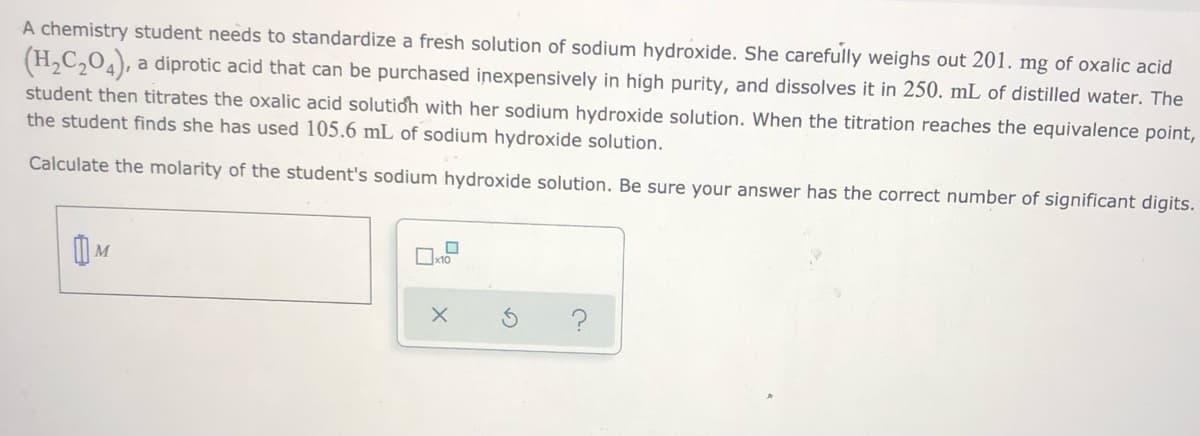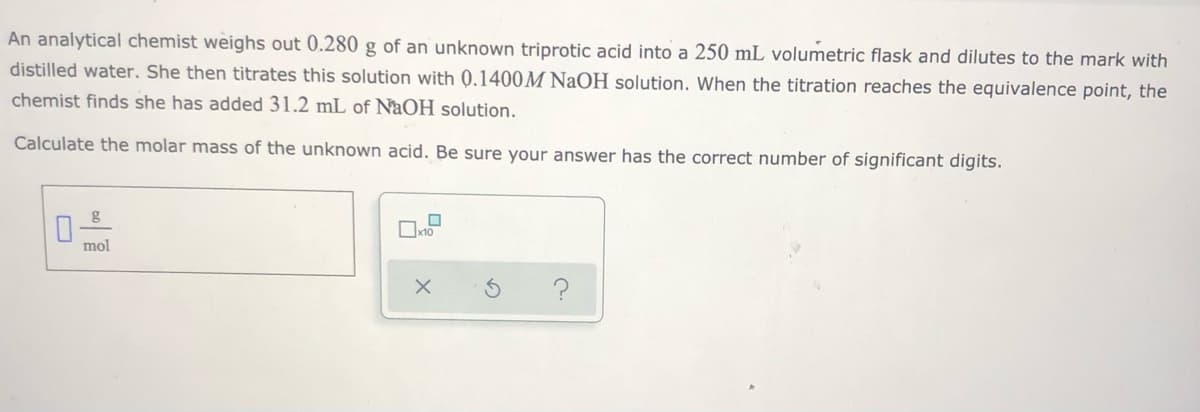A chemistry student needs to standardize a fresh solution of sodium hydroxide. She carefully weighs out 201. mg of oxalic acid (H,C,04), a diprotic acid that can be purchased inexpensively in high purity, and dissolves it in 250. mL of distilled water. The student then titrates the oxalic acid solutioh with her sodium hydroxide solution. When the titration reaches the equivalence point, the student finds she has used 105.6 mL of sodium hydroxide solution. Calculate the molarity of the student's sodium hydroxide solution. Be sure your answer has the correct number of significant digits.
A chemistry student needs to standardize a fresh solution of sodium hydroxide. She carefully weighs out 201. mg of oxalic acid (H,C,04), a diprotic acid that can be purchased inexpensively in high purity, and dissolves it in 250. mL of distilled water. The student then titrates the oxalic acid solutioh with her sodium hydroxide solution. When the titration reaches the equivalence point, the student finds she has used 105.6 mL of sodium hydroxide solution. Calculate the molarity of the student's sodium hydroxide solution. Be sure your answer has the correct number of significant digits.
Chapter9: Acids, Bases, And Salts
Section: Chapter Questions
Problem 9.97E
Related questions
Question
100%

Transcribed Image Text:A chemistry student needs to standardize a fresh solution of sodium hydroxide. She carefully weighs out 201. mg of oxalic acid
(H,C,04), a diprotic acid that can be purchased inexpensively in high purity, and dissolves it in 250. mL of distilled water. The
student then titrates the oxalic acid solutioh with her sodium hydroxide solution. When the titration reaches the equivalence point,
the student finds she has used 105.6 mL of sodium hydroxide solution.
Calculate the molarity of the student's sodium hydroxide solution. Be sure your answer has the correct number of significant digits.

Transcribed Image Text:An analytical chemist weighs out 0.280 g of an unknown triprotic acid into a 250 mL volumetric flask and dilutes to the mark with
distilled water. She then titrates this solution with 0.1400M NaOH solution. When the titration reaches the equivalence point, the
chemist finds she has added 31.2 mL of NaOH solution.
Calculate the molar mass of the unknown acid. Be sure your answer has the correct number of significant digits.
mol
Expert Solution
This question has been solved!
Explore an expertly crafted, step-by-step solution for a thorough understanding of key concepts.
This is a popular solution!
Trending now
This is a popular solution!
Step by step
Solved in 2 steps with 1 images

Knowledge Booster
Learn more about
Need a deep-dive on the concept behind this application? Look no further. Learn more about this topic, chemistry and related others by exploring similar questions and additional content below.Recommended textbooks for you


Chemistry: Principles and Reactions
Chemistry
ISBN:
9781305079373
Author:
William L. Masterton, Cecile N. Hurley
Publisher:
Cengage Learning

Chemistry: An Atoms First Approach
Chemistry
ISBN:
9781305079243
Author:
Steven S. Zumdahl, Susan A. Zumdahl
Publisher:
Cengage Learning


Chemistry: Principles and Reactions
Chemistry
ISBN:
9781305079373
Author:
William L. Masterton, Cecile N. Hurley
Publisher:
Cengage Learning

Chemistry: An Atoms First Approach
Chemistry
ISBN:
9781305079243
Author:
Steven S. Zumdahl, Susan A. Zumdahl
Publisher:
Cengage Learning

Chemistry
Chemistry
ISBN:
9781305957404
Author:
Steven S. Zumdahl, Susan A. Zumdahl, Donald J. DeCoste
Publisher:
Cengage Learning


Chemistry: Principles and Practice
Chemistry
ISBN:
9780534420123
Author:
Daniel L. Reger, Scott R. Goode, David W. Ball, Edward Mercer
Publisher:
Cengage Learning